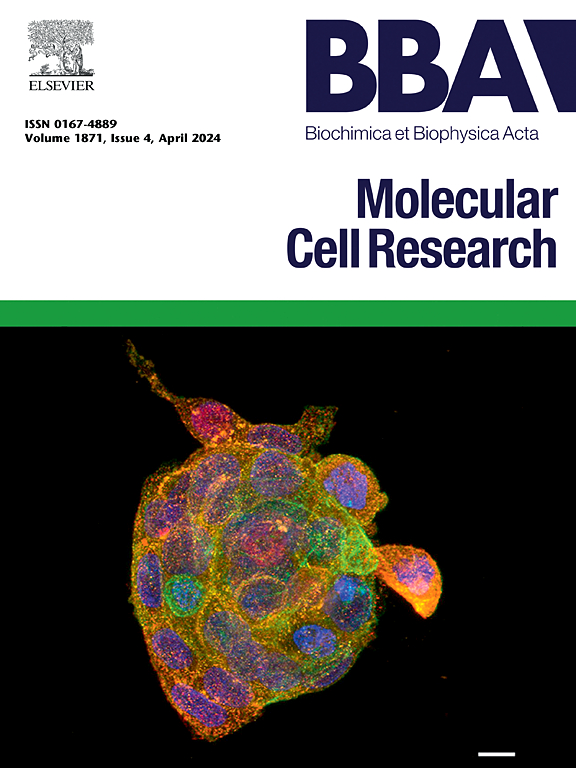COA6缺乏通过JAK/STAT信号通路调节cuprotic抑制肝细胞癌进展。
IF 3.7
2区 生物学
Q1 BIOCHEMISTRY & MOLECULAR BIOLOGY
Biochimica et biophysica acta. Molecular cell research
Pub Date : 2025-09-25
DOI:10.1016/j.bbamcr.2025.120065
引用次数: 0
摘要
背景:肝细胞癌(HCC)是最常见、最致命的恶性肿瘤之一,治疗策略有限。COA6是一种线粒体相关蛋白,在调节肿瘤铜质增生中起重要作用,但其在HCC中的作用目前尚不清楚。本研究旨在探讨COA6在HCC中的表达及其潜在的作用机制。方法:分析TCGA-LIHC数据库中cuprotosis相关基因(CRGs)在HCC中的差异表达及其预后价值,并通过免疫组化和Western blot验证。CCK8、流式细胞术、创面愈合、经井及皮下移植肿瘤检测探讨COA6在HCC中的功能。采用检测试剂盒和Western blot检测COA6对铜生长的影响。采用rna测序法确定其分子机制。采用免疫沉淀法(Co-IP)和免疫荧光法评估COA6与NDUFA4L2之间的关系。western blotting检测COA6对JAK-STAT通路的影响。结果:COA6在HCC组织和HCC细胞系中显著过表达,并与预后不良密切相关。沉默COA6可显著抑制HUH7和HepG2细胞的体外恶性表型和体内肿瘤生长。此外,在HCC细胞中,沉默COA6可促进ROS积累并激活cuproosis。有趣的是,我们发现COA6与NDUFA4L2相互作用,COA6缺乏显著抑制了JAK-STAT信号通路。结论:综上所述,我们的数据表明,COA6在HCC中高表达,沉默COA6可阻断JAK-STAT信号通路,激活cuprotosis,抑制HCC细胞的恶性表型和肿瘤生长。因此,靶向COA6可能是抑制HCC进展的潜在治疗方法。本文章由计算机程序翻译,如有差异,请以英文原文为准。
COA6 deficiency inhibits hepatocellular carcinoma progression by regulating cuproptosis through the JAK/STAT signaling pathway
Background
Hepatocellular carcinoma (HCC) is one of the most common and deadly malignant tumors with limited therapeutic strategies. COA6 is a mitochondria-associated protein that plays an important role in regulating tumor cuproptosis, but its role in HCC is currently unknown. In this study, we aimed to investigate the expression and potential mechanism of action of COA6 in HCC.
Methods
TCGA-LIHC database was analyzed for differentially expressed cuproptosis-related genes (CRGs) in HCC and prognostic value, which was validated by immunohistochemistry and Western blot. CCK8, flow cytometry, wound healing, transwell and subcutaneous graft tumor assays were performed to explore the function of COA6 in HCC. Impact of COA6 on cuproptosis was assessed by assay kit and Western blot. RNA-sequencing were used to determine molecular mechanism. Immunoprecipitation (Co-IP) and immunofluorescence were used to assess the relationship between COA6 and NDUFA4L2. western blotting was used to detect the effect of COA6 on the JAK-STAT pathway.
Results
COA6 was significantly overexpressed in HCC tissues and HCC cell lines and was closely associated with poor prognosis. Silencing COA6 significantly inhibited the malignant phenotype of HUH7 and HepG2 cells in vitro and tumor growth in vivo. Moreover, silencing COA6 promoted ROS accumulation and activated cuproptosis in HCC cells. Interestingly, we found that COA6 interacted with NDUFA4L2 and COA6 deficiency significantly inhibited the JAK-STAT signaling pathway.
Conclusions
In conclusion, our data show that COA6 was highly expressed in HCC, and silencing COA6 blocked the JAK-STAT signaling pathway and activated cuproptosis, and inhibits the malignant phenotype and tumor growth of HCC cells. Therefore, targeting COA6 may be a potential therapeutic approach to inhibit HCC progression.
求助全文
通过发布文献求助,成功后即可免费获取论文全文。
去求助
来源期刊
CiteScore
10.00
自引率
2.00%
发文量
151
审稿时长
44 days
期刊介绍:
BBA Molecular Cell Research focuses on understanding the mechanisms of cellular processes at the molecular level. These include aspects of cellular signaling, signal transduction, cell cycle, apoptosis, intracellular trafficking, secretory and endocytic pathways, biogenesis of cell organelles, cytoskeletal structures, cellular interactions, cell/tissue differentiation and cellular enzymology. Also included are studies at the interface between Cell Biology and Biophysics which apply for example novel imaging methods for characterizing cellular processes.

 求助内容:
求助内容: 应助结果提醒方式:
应助结果提醒方式:


